- Release Notes and Announcements
- Announcements
- Billing Content Adjustment for Cloud Streaming Services Standard Transcoding and Top Speed Codec Transcoding
- Announcement on the Price Adjustment of CSS Audio/Video Enhancement Feature
- Announcement on the Official Billing for CSS Standby Streams Feature
- CSS to Support H.265 8K and AV1 8K Transcoding
- CSS Adds Support for AV1 Codec and Audio/Video Enhancement
- Notice: CSS to Adjust Prices of Basic Services
- CSS to Adjust Pricing of Third-Party Relay
- Delayed Playback to Become Paid Feature
- Announcements
- User Guide
- Product Introduction
- Purchase Guide
- Pricing Overview
- Basic Services
- Value-Added Services
- Live Transcoding (Watermarking, Stream Mixing, subtitles)
- Live Audio and Video Enhancement
- Live Recording
- Time Shifting (New)
- Live Screencapture
- Live Stream Moderation
- Intelligent Porn Detection
- Live Video Caster
- Relay
- Overview of Basic Fees for Value-Added Features
- Delayed Playback
- Standby Streams
- Real-Time Log Shipping
- Prepaid plan
- Purchase Process
- Changing Billing Modes
- Refund Policy
- Viewing Bills
- Renewal
- Processing for Overdue Payments
- Billing FAQs
- Live Video Broadcasting (LVB)
- Live Event Broadcasting (LEB)
- Live Video Caster
- Console Guide
- Console Overview
- Overview
- Domain Management
- Adding Domain Names
- Push Domain Name Management
- Push Configuration
- Recording Configuration
- Time Shifting Configuration
- Screencapture and Porn Detection Configuration
- Watermark Configuration
- Callback Configuration
- Standby Stream Configuration
- Latency Control
- IP Blocklist/Allowlist Configuration
- Delayed Playback
- Moderation Configuration
- Remote Authentication Configuration
- Playback Domain Name Management
- Playback Configuration
- Playback Authentication Configuration
- Referer Configuration
- Template Configuration
- HTTPS Configuration
- Region Configuration
- Origin Server Configuration
- Bandwidth Cap Configuration
- IP Blocklist/Allowlist Configuration
- Blocking Playback by Protocol
- Latency Control
- HTTP Response Header Configuration
- Access control by region Configuration
- Remote Authentication Configuration
- Certificate Management
- Stream Management
- Package Management
- Feature Configuration
- Relay
- Billing Usage Statistics
- Monitoring
- Toolkit
- OOTB live
- CAM-Based Access Control
- Feature Guide
- Push and Playback
- Features
- Live Streaming Security
- Global CSS Service
- Callback Notifications
- How to Receive Event Notification
- Stream Pushing Notification
- Recording Event Notification
- Recording Status Event Notification
- Screencapturing Event Notification
- Live Broadcasting Image Audit Event Notification
- Live Streaming Audio Auditing Service Event Notification
- Push Error Event Notifications
- Relay Event Notification
- User Guides for Common Third-Party Tools
- SDK Guide
- API Documentation
- History
- Introduction
- API Category
- Making API Requests
- Live Transcoding APIs
- Delayed Playback Management APIs
- Domain Name Management APIs
- Watermark Management APIs
- Certificate Management APIs
- Live Stream Mix APIs
- Stream Pulling APIs
- Recording Management APIs
- Time Shifting APIs
- Live Callback APIs
- Screencapturing and Porn Detection APIs
- Authentication Management APIs
- Monitoring Data Query APIs
- DescribeAllStreamPlayInfoList
- DescribeGroupProIspPlayInfoList
- DescribeHttpStatusInfoList
- DescribeLiveDomainPlayInfoList
- DescribeLiveStreamPushInfoList
- DescribeLiveTranscodeDetailInfo
- DescribePlayErrorCodeDetailInfoList
- DescribePlayErrorCodeSumInfoList
- DescribeProIspPlaySumInfoList
- DescribeProvinceIspPlayInfoList
- DescribeStreamDayPlayInfoList
- DescribeStreamPlayInfoList
- DescribeStreamPushInfoList
- DescribeTopClientIpSumInfoList
- DescribeVisitTopSumInfoList
- Billing Data Query APIs
- Live Stream Management APIs
- Data Types
- Error Codes
- Ops Guide
- Troubleshooting
- About Pushing
- Playing Method
- Live Streaming Quiz
- FAQs
- SLA
- CSS Policy
- Glossary
- Release Notes and Announcements
- Announcements
- Billing Content Adjustment for Cloud Streaming Services Standard Transcoding and Top Speed Codec Transcoding
- Announcement on the Price Adjustment of CSS Audio/Video Enhancement Feature
- Announcement on the Official Billing for CSS Standby Streams Feature
- CSS to Support H.265 8K and AV1 8K Transcoding
- CSS Adds Support for AV1 Codec and Audio/Video Enhancement
- Notice: CSS to Adjust Prices of Basic Services
- CSS to Adjust Pricing of Third-Party Relay
- Delayed Playback to Become Paid Feature
- Announcements
- User Guide
- Product Introduction
- Purchase Guide
- Pricing Overview
- Basic Services
- Value-Added Services
- Live Transcoding (Watermarking, Stream Mixing, subtitles)
- Live Audio and Video Enhancement
- Live Recording
- Time Shifting (New)
- Live Screencapture
- Live Stream Moderation
- Intelligent Porn Detection
- Live Video Caster
- Relay
- Overview of Basic Fees for Value-Added Features
- Delayed Playback
- Standby Streams
- Real-Time Log Shipping
- Prepaid plan
- Purchase Process
- Changing Billing Modes
- Refund Policy
- Viewing Bills
- Renewal
- Processing for Overdue Payments
- Billing FAQs
- Live Video Broadcasting (LVB)
- Live Event Broadcasting (LEB)
- Live Video Caster
- Console Guide
- Console Overview
- Overview
- Domain Management
- Adding Domain Names
- Push Domain Name Management
- Push Configuration
- Recording Configuration
- Time Shifting Configuration
- Screencapture and Porn Detection Configuration
- Watermark Configuration
- Callback Configuration
- Standby Stream Configuration
- Latency Control
- IP Blocklist/Allowlist Configuration
- Delayed Playback
- Moderation Configuration
- Remote Authentication Configuration
- Playback Domain Name Management
- Playback Configuration
- Playback Authentication Configuration
- Referer Configuration
- Template Configuration
- HTTPS Configuration
- Region Configuration
- Origin Server Configuration
- Bandwidth Cap Configuration
- IP Blocklist/Allowlist Configuration
- Blocking Playback by Protocol
- Latency Control
- HTTP Response Header Configuration
- Access control by region Configuration
- Remote Authentication Configuration
- Certificate Management
- Stream Management
- Package Management
- Feature Configuration
- Relay
- Billing Usage Statistics
- Monitoring
- Toolkit
- OOTB live
- CAM-Based Access Control
- Feature Guide
- Push and Playback
- Features
- Live Streaming Security
- Global CSS Service
- Callback Notifications
- How to Receive Event Notification
- Stream Pushing Notification
- Recording Event Notification
- Recording Status Event Notification
- Screencapturing Event Notification
- Live Broadcasting Image Audit Event Notification
- Live Streaming Audio Auditing Service Event Notification
- Push Error Event Notifications
- Relay Event Notification
- User Guides for Common Third-Party Tools
- SDK Guide
- API Documentation
- History
- Introduction
- API Category
- Making API Requests
- Live Transcoding APIs
- Delayed Playback Management APIs
- Domain Name Management APIs
- Watermark Management APIs
- Certificate Management APIs
- Live Stream Mix APIs
- Stream Pulling APIs
- Recording Management APIs
- Time Shifting APIs
- Live Callback APIs
- Screencapturing and Porn Detection APIs
- Authentication Management APIs
- Monitoring Data Query APIs
- DescribeAllStreamPlayInfoList
- DescribeGroupProIspPlayInfoList
- DescribeHttpStatusInfoList
- DescribeLiveDomainPlayInfoList
- DescribeLiveStreamPushInfoList
- DescribeLiveTranscodeDetailInfo
- DescribePlayErrorCodeDetailInfoList
- DescribePlayErrorCodeSumInfoList
- DescribeProIspPlaySumInfoList
- DescribeProvinceIspPlayInfoList
- DescribeStreamDayPlayInfoList
- DescribeStreamPlayInfoList
- DescribeStreamPushInfoList
- DescribeTopClientIpSumInfoList
- DescribeVisitTopSumInfoList
- Billing Data Query APIs
- Live Stream Management APIs
- Data Types
- Error Codes
- Ops Guide
- Troubleshooting
- About Pushing
- Playing Method
- Live Streaming Quiz
- FAQs
- SLA
- CSS Policy
- Glossary
With CSS, you can record a live stream and save the recording file to VOD or COS. This document shows you how to record to Cloud Object Storage (COS).
Notes
To record to COS, you need to activate COS first. We recommend you buy a storage package in advance to avoid service suspension caused by overdue payments. For details, see COS > Getting Started.
After enabling the recording feature, please make sure that your COS service is in normal status. If COS is not activated or is suspended due to overdue payments, live recording will fail. No recording files will be generated. Nor will fees be incurred.
A recording file is available about five minutes after recording ends. For example, if you start recording a live stream at 12:00 and stop at 12:30, you can get the recorded video at around 12:35.
After creating a recording template, you need to bind it to a push domain. For detailed directions, see "Recording Configuration". The template takes effect 5-10 minutes after binding.
Mixed-stream recording does not support mixing streams inside the Chinese mainland with streams outside. Doing so will cause an error and playback of the recording file will fail.
CSS needs permissions to store recording files in COS. Before you use the record-to-COS feature, make sure you have granted the necessary permission. If recording to COS fails due to insufficient permissions, the video cannot be recovered. For how to grant the permission, see "Authorizing CSS to Store Recording Files in COS".
Due to the default traffic and QPS limits of COS storage buckets, if your estimated concurrent push streams exceed 5000, please Submit a Ticket to adjust the QPS limit to avoid affecting the normal use of your business.
If you do not specify a recording template when initiating a recording task, the recording file will be saved to VOD.
Prerequisites
You have activated CSS and added a push domain.
You have activated COS.
Creating a Recording Template
1. Log in to the CSS console and select Feature Configuration > Live Recording on the left sidebar.
2. Select Save to COS.

3. Click Create template to set the template information and proceed with the following configurations:
Basic recording configuration: This includes the template name, recording content, recording format, and other configuration items. For details, see Basic Recording Configuration Instructions.
Basic recording format configuration: This includes HLS file segmentation, max recording time per file, resumption timeout, and other configuration items. For details, see Basic Recording Format Configuration Instructions.
(Optional) Advanced recording format configuration: By clicking Advanced Configuration , you can access and select additional configurations. For details, see Advanced Recording Format Configuration Instructions.
4. Upon completion, click Save .
Basic Recording Configuration Instructions
Note:
If you select Original stream, you cannot record the audio of WebRTC streams.
You cannot record transcoded streams if you use the time shifting feature. If time shifting is enabled for a stream, the original stream will be recorded.
If an audio-only transcoding template is selected, the recording format must also be an audio format.
To record a transcoded live stream, you need to configure a transcoding task for the stream in advance. This will incur transcoding fees. Transcoding fees will be charged only once for playback of the same transcoded stream (same transcoding template).
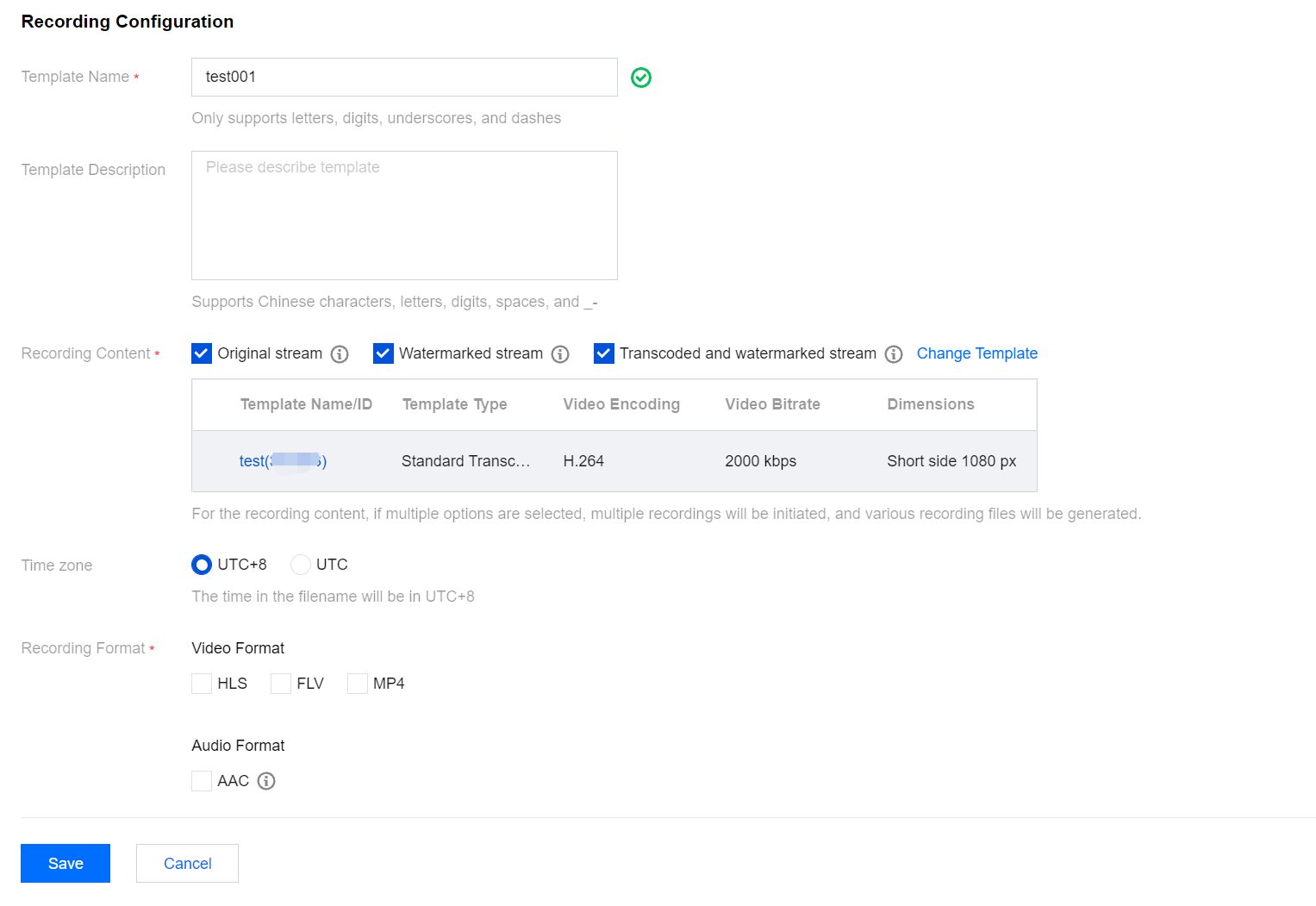
Basic Configuration Item | Description | |
Template Name | | The template name, which can contain letters, digits, underscores (_), and hyphens (-). |
Template Description | | The template description, which can be customized and can contain Chinese and English characters, digits, spaces, underscores (_), and hyphens (-). |
Recording Content | Original stream | The recording video records the original stream by default and retains its original bitrate. Record videos before transcoding, watermarking, and stream mixing. For WebRTC streams, please select other content types, because the audio playback may be not compatible. |
| Watermarked stream | Record videos after they are watermarked according to the specified watermark template. If no watermark template is configured, original streams will be recorded. |
| Transcoded and watermarked stream | Click Transcoded and watermarked stream . You can select an existing transcoding template or click the name of a template to modify its configuration.
Choosing this configuration will automatically initiate transcoding based on the transcoding template ID after push, and recording will proceed. If the transcoding template has been mistakenly deleted, the effect will be the same as recording content as watermarked streams. |
Time zone | | You can select UTC+8 or UTC . When UTC+8 is selected as the timezone, the naming of the recording files will use the UTC+8 time. When UTC is selected as the timezone, the naming of the recording files will use the UTC time. |
Recording Format | | Videos can be output in formats of HLS, MP4, FLV, and AAC (for audio-only recording). |
Basic Recording Format Configuration Instructions
Note:
Since the recording file is uploaded as it is recorded, it is impossible to ascertain the end time before uploading, preventing the inclusion of the end time in the file name.
Enabling simultaneous recording and uploading ensures files are uploaded immediately after recording ends. A single recording file supports a duration of up to 12 hours and enhances FLV recording's disaster recovery capability. Playback files may experience lag when being dragged for online playback, but this does not affect local playback.
1. Select the recording content and formats and complete the following settings:
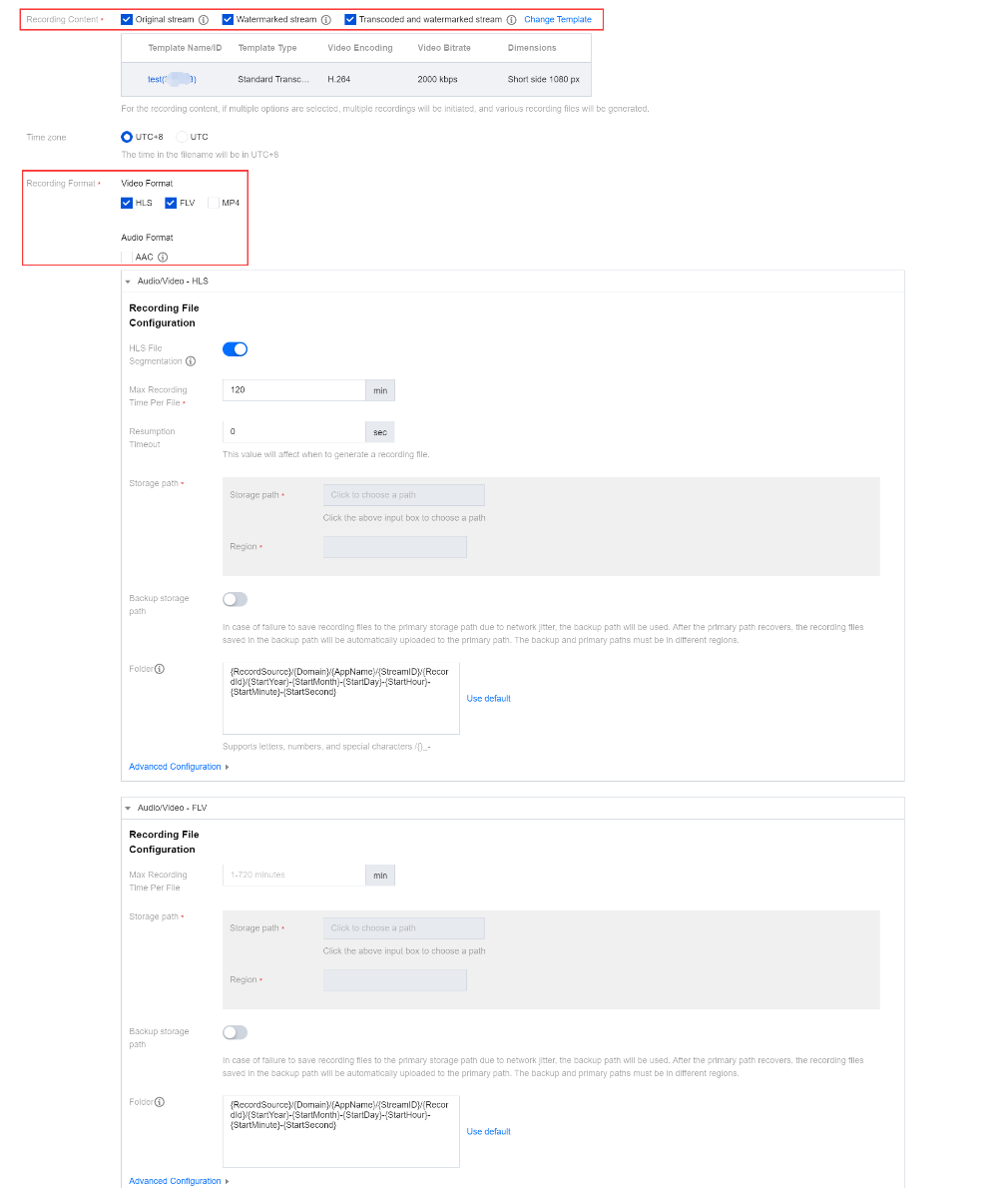
Basic Recording Format Configuration Item | Description |
HLS File Segmentation | The HLS file segmentation feature is disabled by default. If post-processing services are needed, it is recommended to enable HLS file segmentation and set the duration of individual HLS recording files. If HLS file segmentation is enabled, the duration of individual HLS recording files can be configured, allowing for the definition of the duration of files produced by post-recording processing. If HLS file segmentation is disabled, recording will continue uninterrupted until the live stream ends. If post-recording processing has been configured, it will be initiated after the recording is complete. |
Max Recording Time Per File (min) | Audio/Video - HLS format There is no upper limit on the recording duration of a file in HLS format. If the waiting time for continuation of recording is exceeded, a new recording file will be generated to continue recording. When an HLS recording file is saved to COS, the duration of a single TS file is set to 10 seconds by default. When HLS file segmentation is enabled, the duration of a single HLS recording file can range from 1 to 720 minutes. Audio/Video - FLV format The duration of a single file recorded in FLV format is limited to 1 to 720 minutes. Audio/Video - MP4 format The duration of a single file recorded in MP4 format is limited to 1 to 120 minutes. Audio-only - AAC format The duration of a single file recorded in AAC format is limited to 1 to 120 minutes. |
Resumption Timeout (sec) | The resumption timeout period directly affects the time it takes to generate a recording file. When the interval of stream interruption does not exceed the set resumption timeout period, a single live stream will generate only one file. However, the recording file will be received after the resumption timeout period has elapsed, and recording costs will be incurred during the resumption timeout period. Please set a reasonable resumption timeout period. Only HLS format supports resuming recording after stream interruptions, with the resumption timeout period being configurable from 1 to 1,800 seconds. |
Storage path | You can select a COS bucket from buckets that you have created and completed authorization in Cloud Object Storage . The region is the region of the mentioned bucket, which cannot be modified. |
Backup storage path | The backup storage path feature is disabled by default. You can manually enable this feature according to your business needs. When network jitter prevents the recording file from being stored in the primary storage path, the system will automatically store it in the backup storage path to prevent file loss. Once the primary storage path is restored, the recording file in the backup storage path will be automatically synchronized to the primary storage path. The primary and secondary regions cannot be the same. |
Folder | The default storage folder is {RecordSource}/{Domain}/{AppName}/{StreamID}/{RecordId}/{StartYear}-{StartMonth}-{StartDay}-{StartHour}-{StartMinute}-{StartSecond}.{RecordSource}indicates the content type. If the original stream is recorded, this is "origin". If a transcoded stream is recorded, this is the transcoding template ID.{StartYear}indicates the starting year.{StartMonth}indicates the starting month.{StartDay}indicates the starting day.{StartMinute}indicates the starting minute.{StartSecond}indicates the starting second.{Domain}indicates the push domain.{AppName} indicates the push path.{StreamID} indicates the stream ID.{RecordId}indicates the recording task ID, which is returned by the CreateRecordTask API.(/) indicates folder levels. (-) is an ordinary character. |
2. Click Save.
Advanced Recording Format Configuration Instructions
1. Log in to the CSS console and select Feature Configuration > Live recording > Save to COS > Create template > Recording Format > Advanced Configuration.
Note:

Prerequisite: Since this is the first time activating the post-recording MPS feature , the Cloud Streaming Services console needs to call the Media Processing Service (MPS), requiring you to create a service role and authorize the current account role to use the MPS product.
2. Click authorize to enter the CAM role management page.

3. On the role management page, click Grant to complete the identity verification and finalize the MPS authorization, enabling normal use of the MPS.

4. After successful authorization, the system will automatically activate the MPS product and display the Save to COS page.
5. Choose Create template > Recording Format > Advanced Configuration , and proceed with the following configuration:
5.1 You can switch between different tabs to view the configuration requirements for Audio/Video - HLS format, Audio/Video - FLV format, Audio/Video - MP4 format, and Audio-only - AAC format.

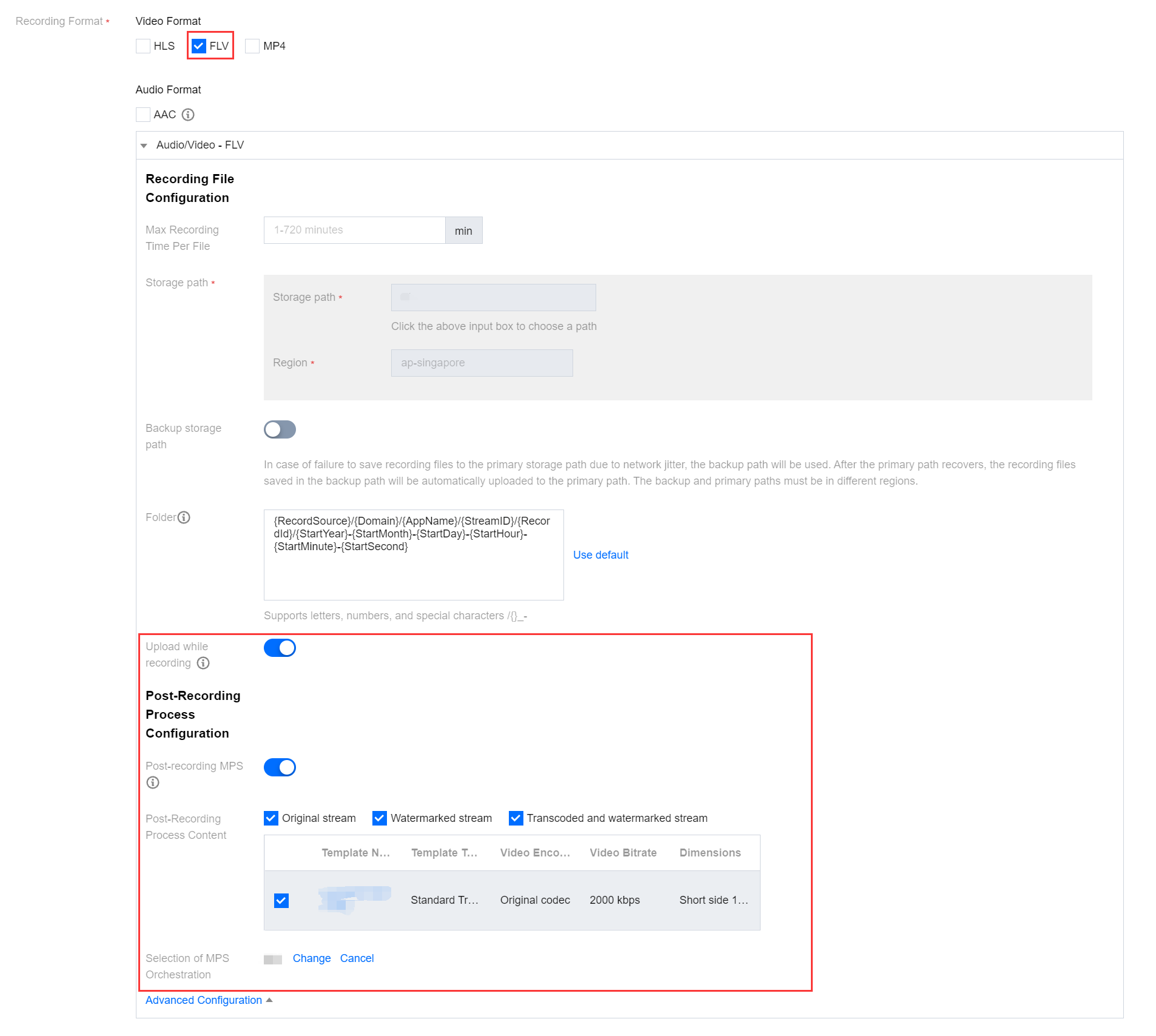

After you select this format, AAC files will be generated when audio-only or quasi-audio/video live streams are pushed.

Advanced Configuration Item | Description |
Post-Recording Process Configuration | The post-recording MPS feature is disabled by default. You can manually enable this feature based on your business needs. After enabling the post-recording MPS, no post-recording process content is selected by default. You need to manually select the corresponding process content. When HLS, FLV, MP4, and AAC audio and video formats are enabled with post-recording processing, MPS orchestration cannot be empty. After enabling the post-recording MPS, you can use the MPS orchestration to transcode, repackage, and perform a series of other post-processing services on the original recording files. The storage setting for the processed files is determined by the MPS orchestration task settings, while the original recording files are still retained. You can cancel or change the MPS orchestration . You can click to select the bound MPS orchestration and choose an orchestration already created under the MPS orchestration application, or click the orchestration name on the current MPS orchestration selection page to go to the MPS console to add/modify the orchestration configuration. After the orchestration is successfully bound, the MPS template will be executed after the recording file is generated, incurring corresponding Media Processing fees. |
Upload while recording | The upload while recording feature is disabled by default. You can manually enable this feature based on your business needs. Currently, only the FLV format supports the upload while recording feature . Once enabled, it allows immediate upload of files after recording ends, supports a recording file duration of up to 12 hours, and enhances FLV recording's disaster recovery capability. Playback files may experience lag when being dragged for online playback, but this does not affect local playback. |
Binding a Domain Name
1. Log in to the CSS console, select Feature Configuration > Live Recording on the left sidebar, and click Save to COS.
Bind a domain to an existing template: Click Bind Domain Name in the top left.

Bind a domain after creating a template: After creating a template, click Bind Domain Name in the dialog box that pops up.

2. In the pop-up window, select a Recording template and a Push domain and then click Confirm.
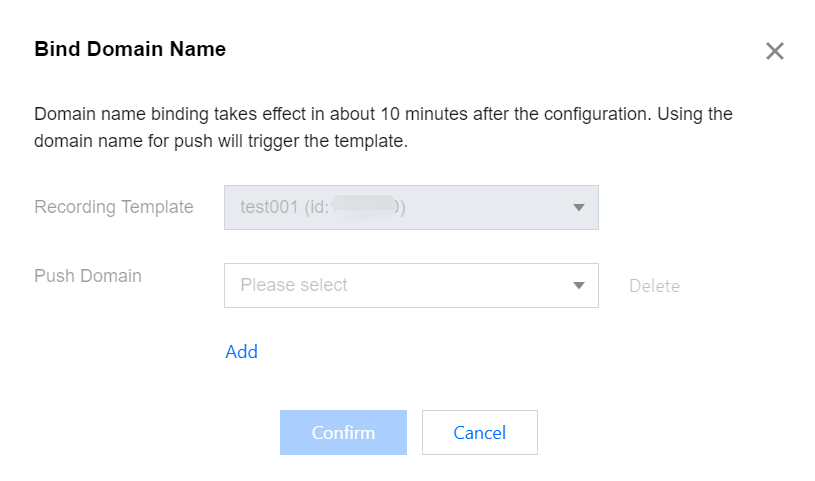
Note:
You can click Add to bind multiple push domains to a template.
Unbinding a Domain Name
1. Log in to the CSS console, select Feature Configuration > Live Recording on the left sidebar, and click Save to COS.
2. Select a recording template bound with domain names, find the target domain name, and click Unbind.

3. In the pop-up window, click Confirm.
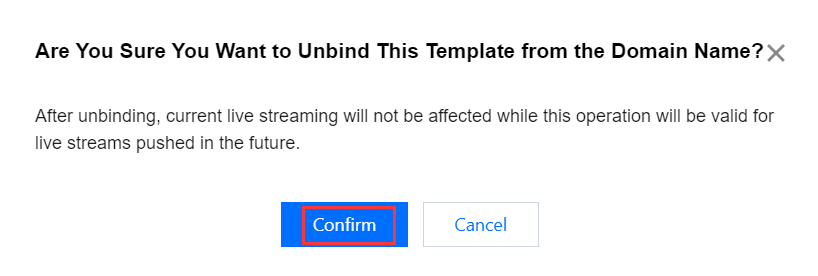
Note:
Unbinding the recording template will not affect ongoing live streams.
To cancel recording for ongoing streams, stop the streams and push them again.
Modifying a Template
1. Go to Feature Configuration > Live Recording and select Save to COS.
2. Select the target recording template and click Edit on the right to modify the template information.
3. Click Save.
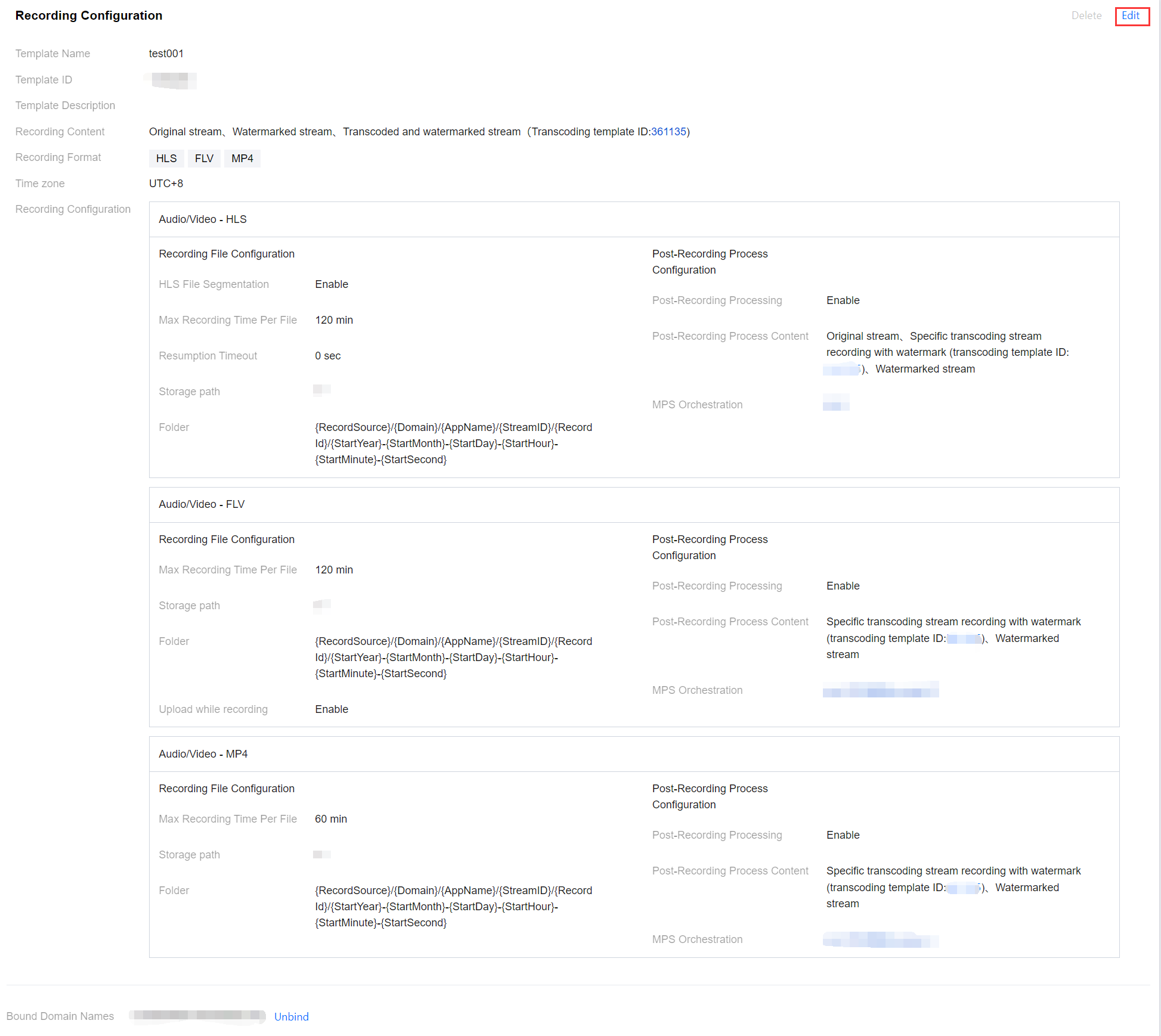
Deleting a Template
Note:
If the template has been associated, you need to first unbind it before you can delete it.
Once a template is deleted, it cannot be restored. Please proceed with caution.
The management of recording templates in the console is at the domain name level, and currently, it is impossible to cancel the rules created by the associated interface. If you have associated a specific stream through the recording management interface, you will need to call Delete Recording Rule to unbind it.
1. Log in to the CSS console, select Feature Configuration >Live Recording on the left sidebar, and click Save to COS.
2. Select the target recording template, and click Delete in the upper right.
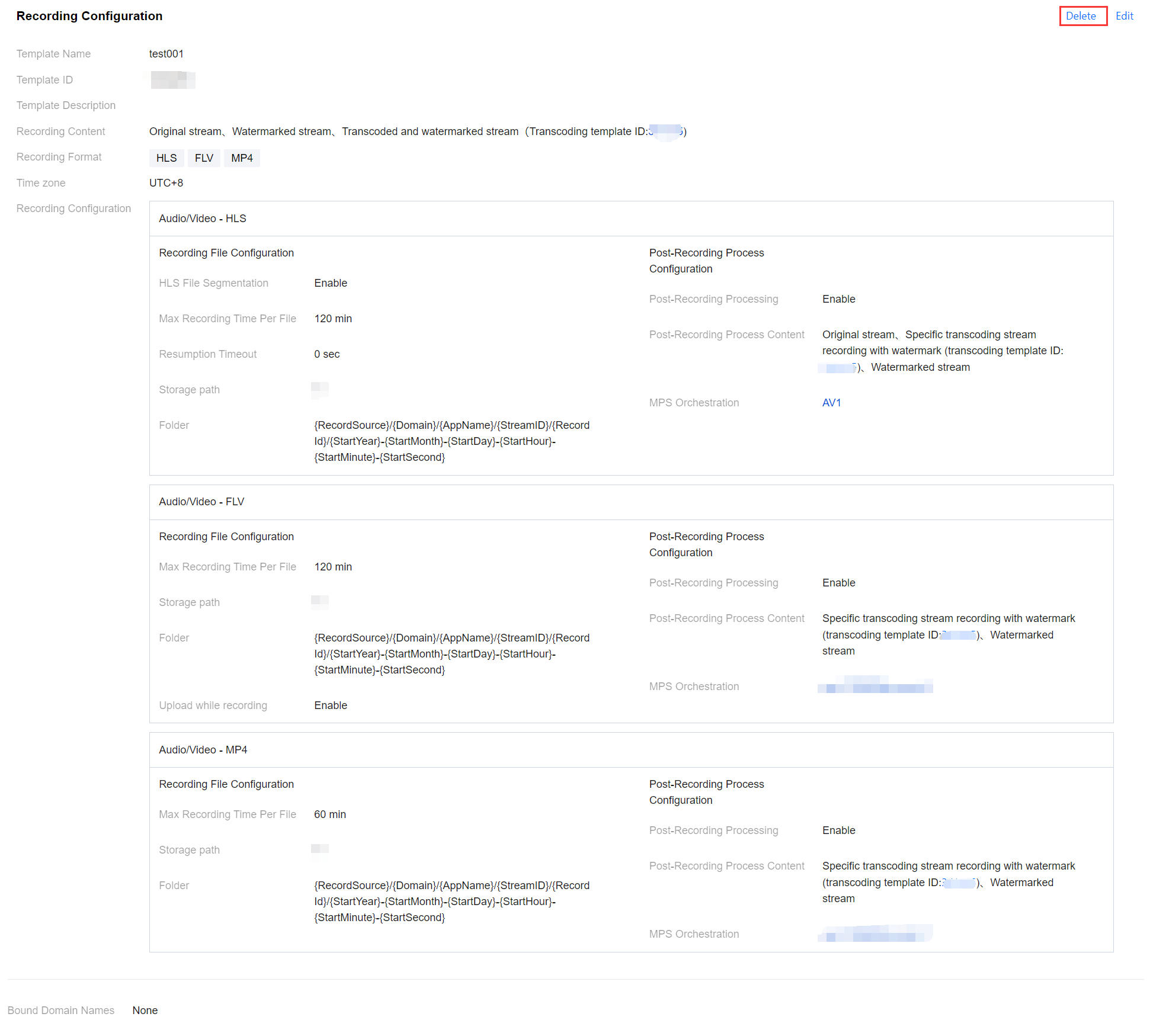
3. In the pop-up window, click Confirm.

More
You can also unbind and bind domains and recording templates on the Domain Management page. For details, see Recording Configuration.

 Yes
Yes
 No
No
Was this page helpful?